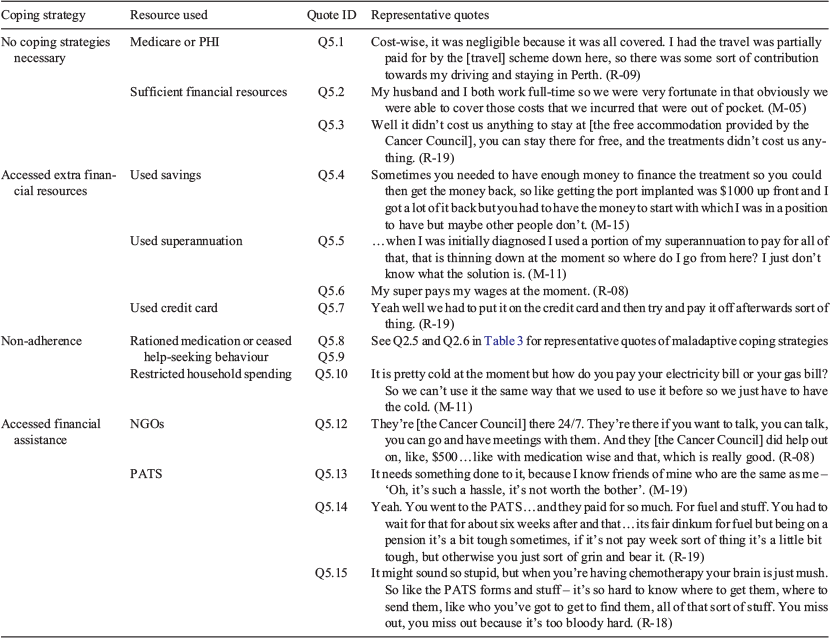‘…If I don’t have that sort of money again, what happens?’: adapting a qualitative model to conceptualise the consequences of out-of-pocket expenses for cancer patients in mixed health systems
Jade C. Newton A , Harry Hohnen A , Claire E. Johnson A B C , Angela Ives A , Sandy McKiernan D , Violet Platt E , Christobel Saunders A and Neli Slavova-Azmanova A F
A , Harry Hohnen A , Claire E. Johnson A B C , Angela Ives A , Sandy McKiernan D , Violet Platt E , Christobel Saunders A and Neli Slavova-Azmanova A F
A UWA Medical School, The University of Western Australia, M507, 35 Stirling Highway, Crawley, WA 6009, Australia. Email: harry.hohnen@uwa.edu.au; angela.ives@uwa.edu.au; Christobel.Saunders@uwa.edu.au; jade.newton@uwa.edu.au
B School of Nursing and Midwifery, Monash University, Wellington Road, Clayton, Vic. 3800, Australia. Email: Claire.Johnson@easternhealth.org.au
C Eastern Health, Box Hill, Vic. 3128, Australia.
D Cancer Council Western Australia, 420 Bagot Road, Subiaco, WA 6008, Australia. Email: sandy.mckiernan@svdpwa.org.au
E WA Cancer and Palliative Care Network, 4th Floor, A Block, Verdun Street, Nedlands, WA 6009, Australia. Email: Violet.Platt@health.wa.gov.au
F Corresponding author. Email: Neli.Slavova-Azmanova@uwa.edu.au
Australian Health Review 44(3) 355-364 https://doi.org/10.1071/AH18250
Submitted: 5 December 2018 Accepted: 23 September 2019 Published: 22 January 2020
Journal Compilation © AHHA 2020 Open Access CC BY-NC-ND
Abstract
Objective The aim of this study was to explore Western Australian cancer patients’ experiences of out-of-pocket expenses (OOPE) during diagnosis and cancer treatment using a phenomenological approach.
Methods Semi-structured interviews were conducted with a purposive convenience sample of 40 Western Australian cancer patients diagnosed with breast, lung, prostate or colorectal cancer. Participants were asked about the impact of their diagnosis, the associated costs and their experience within the health system. Data were analysed using thematic content analysis.
Results Three key themes influencing participant OOPE experiences were identified: (1) personal circumstances; (2) communication with health providers; and (3) coping strategies. Despite Australia’s public healthcare system, several participants found the costs affected their financial security and resorted to coping strategies including medication rationing and restrictive household budgeting. The key themes had a complex and interrelated effect on patient OOPE experiences and were used to adapt Carrera et al.’s model of economic consequences of cancer treatment on the patient and patient coping to describe these relationships in a mixed healthcare system.
Conclusion Organised efforts must be implemented to mitigate maladaptive coping strategies being used by cancer patients: (1) health providers should seek informed financial consent from patients before commencing treatment; and (2) financial aid and support schemes for cancer patients should be reviewed to ensure they are delivered equitably.
What is known on this topic? The financial cost of cancer can have significant adverse effects on cancer patients. Although financial transparency is desired by cancer patients, its implementation in practice is not clear.
What does this paper add? This study adapts a conceptual model for the economic consequences of a cancer diagnosis and repurposes it for a mixed public–private health system, providing a framework for understanding downstream consequences of cancer costs and highlighting opportunities for intervention.
What are the implications for health practitioners? Health practitioners need to initiate discussions concerning treatment costs earlier with cancer patients. There are several resources and guides available to assist and facilitate financial transparency. Without urgent attention to the financial consequences of cancer treatment and related expenses, we continue to leave patients at risk of resorting to maladaptive coping strategies, such as medication rationing and restrictive household budgeting.
Additional keywords: financial burden, health expenditure, outer metropolitan population, qualitative research, rural population.
Introduction
Out-of-pocket expenses (OOPE) associated with cancer can result from direct (treatment and travel to treatment centres) and indirect (e.g. loss of income due to time taken off work) costs.1 The magnitude of expenses varies across health systems, yet even citizens in countries with universal healthcare systems, such as Australia and Canada, can incur life-altering costs associated with their treatment.2 The worst effects of financial stress are termed ‘financial toxicity’,3,4 which is measured through monetary (absolute costs accrued by the patient), objective (methods used to ease financial burden) and subjective (perceived financial burden) measures.2
Although some researchers and clinicians are attempting to incorporate price transparency into conversations with patients,5,6 the effects of cancer costs remain an issue of growing importance,7–10 and are a primary issue that Australian health consumers and cancer patient organisations have identified requiring further action.11–13 To support health services and policy makers to address their concerns, a model or framework underpinning the patient experiences in a public–private setting would contribute towards identifying areas to target and address. Carrera et al.14 have developed a model to describe the economic consequences of cancer treatment on patients and patient coping based on research undertaken in private health systems.
We are aware of one qualitative study that has explored this issue within Australia,15–19 and several others undertaken internationally.20–22 Due to the heterogeneity in patient cost experiences largely related to personal, financial and treatment-related factors,23 further qualitative research would elaborate on cancer patient experiences in a public–private health system and contribute to developing a framework through which we can identify areas to improve patient cost experiences.
In this study we explored the complex narratives of cancer patients undergoing treatment and the impact of OOPE on their experience to gain an insight into their subjective and objective experiences of financial toxicity.
Methods
Context and setting
Most tertiary hospitals in Western Australia (WA) are located in the capital city, Perth. Some densely populated outer-metropolitan suburbs and large regional towns have hospitals with specialised cancer units. Patients in rural and remote areas are exposed to larger non-medical expenses because they travel to and stay near treatment centres.24–27 Some medical treatments and pharmaceutical costs are covered by Medicare (the universal Australian health scheme), and all Australian residents have access to free treatment in hospitals that are publicly owned, or public–private partnerships.28 Private health insurance (PHI) is available for Australians to opt into and provides varying levels of cover for access to private hospital and ancillary health services. Concession and healthcare cards are available to pensioners, social security recipients and people with low incomes to subsidise health service and medication costs.29 Australians who are not eligible for a healthcare card are supported by a ‘safety net’, whereby they pay the same subsidised rates once a certain out-of-pocket threshold for out-of-hospital services and medication has been reached.30,31 Between 2014 and 2017, 46–47% of Australians had PHI coverage for hospital treatment, and 56% had PHI coverage for ancillary services.32,33 To reduce pressure on the public system, the Australian government incentivises PHI uptake through income taxation. An income-tested Medicare levy of 1–1.5% is incurred by taxpayers who do not have PHI coverage for hospital treatment. Furthermore, PHI holders earning below a threshold amount receive an income-tested PHI rebate, which is an amount that the government contributes towards the cost of their PHI premiums.28 Financial assistance is available through the Patient Assistance Travel Scheme (PATS) to supplement travel costs for patients, provided strict eligibility criteria are met.34 Additional financial support is available from non-governmental organisations (NGOs) such as the Cancer Council.
Study design, recruitment and participants
A purposive convenience sample of 40 rural and outer metropolitan participants who had participated in the Out-of-Pocket Expenses Study35 participated in semistructured, in-depth interviews after treatment completion. The sample was chosen to obtain a diverse range of participants based on the cancer type, demographic, treatment and financial characteristics, as presented in Table 1. Participant recruitment via the WA Cancer Registry has been described elsewhere.35
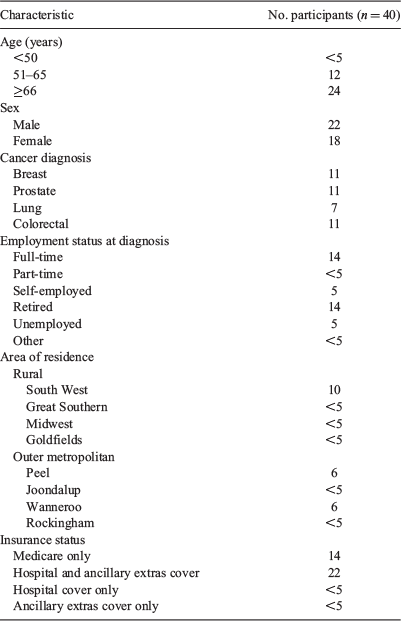
|
Of 559 participants who consented to the study, 339 (61%) consented to follow-up contact and 59 (11%) were contacted. Of the 59 participants contacted, 10 participants declined the interview request and nine were lost to follow-up. Forty participants consented to being interviewed. Ethics approval was obtained from the WA Country Health Service Ethics Committee (#2014:10) and the Department of Health WA Human Research Ethics Committee (#2014/26).
Data collection and analysis
Interviews were conducted by research assistants in 2016 and 2017. Training in the interview process was provided by an experienced member of the research team (CEJ). Prior to commencing interviews, the research assistants were familiarised with the interview guide (Table 2). Interviews were audio recorded and, on average, were 37 min long. Interviews were guided by seven broad questions designed to focus on the patient experience throughout diagnosis and treatment, with particular attention to the impacts of the costs of cancer diagnosis and treatment.
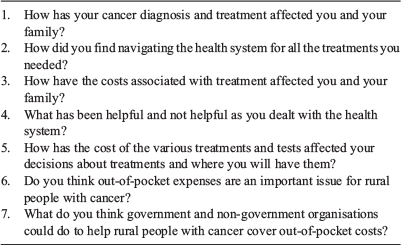
|
The interviews were transcribed verbatim by a third party, and were stored and managed in NVivo 11 (QSR International Pty Ltd, Melbourne, Vic., Australia). Data were analysed using a phenomenological approach, with emphasis on the subjective meaning of the participants’ experiences. This approach was chosen due to the moderate body of research that has been undertaken thus far into cancer patients’ OOPE; hence, we did not want to constrain the analysis with preconceptions and potentially overlook important aspects of participants’ experiences.36
Transcripts were reviewed and a preliminary coding list was developed in NVivo through collaborative discussions and mutual agreement. Once established, thematic content analysis was undertaken by research assistants.37 A cross-comparative approach across the raw data, codes and emerging themes facilitated confirmation and validation of the conclusions. Themes were audited by a team member (NSA) who did not participate in the content analysis to ensure they were congruent with the transcripts.
Results
Patient experiences of OOPE
Participants’ experiences of OOPE fell into three broad themes that mediated their OOPE experiences: patient circumstances, communication and patient coping strategies.
All participants accrued medical and non-medical OOPE while accessing cancer care and treatment. Their experiences were affected by the size of the OOPE incurred, patient-specific circumstances and their ability to navigate the healthcare system. Representative quotes are presented in Table 3. Some participants had most or all treatment costs covered by Medicare and their PHI (42.5%). Four participants who had PHI discovered that the diagnostic tests or treatment they required were not covered by their insurance company. Nine participants (22.5%) noted the effect of ‘incidental’ expenses, such as products required for the management of side effects and complications (Table 3, Q2.1).
Four participants noted their OOPE were outweighed by the importance of regaining their health (Table 3, Q2.7 and Q2.8). Conversely, two participants found the cumulative costs for medications burdensome, and stopped seeking treatment to manage side effects and complications to alleviate their financial burden (Table 3, Q2.5 and Q2.6). Patient OOPE experiences were further ameliorated or exacerbated by patients’ personal circumstances and communication with health providers, which, in turn, affected the strategies they used to deal with their OOPE.
Patient circumstances
Proximity to treatment locations and personal financial and employment situations were factors affecting participant experiences, as illustrated by representative quotes presented in Table 4.
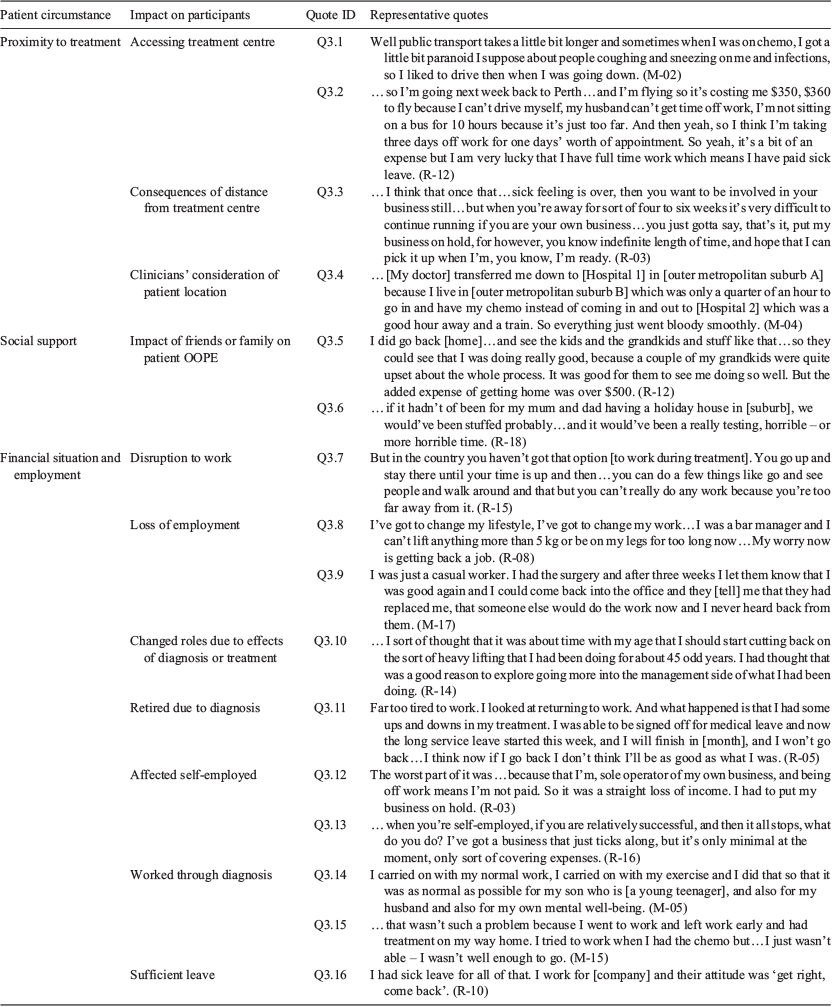
|
Proximity to treatment
Participants reported great variation in proximity and access to the services they required. Participants saw being able to easily access the treatment centre as a great benefit. Hospital parking fees were considered a big contributor to OOPE.
Some participants acknowledged the role of clinicians in minimising their travel by arranging for treatment close to participants’ residences. Others felt the burden of travel was not taken into account in their diagnostic and treatment pathways (Table 4, Q3.2). Participants commented on the implications of travel for treatment on their employment situation, continuity of care and the complex effect on their need for social support. Participants also acknowledged the role of financial travel and accommodation assistance and support from NGOs.
The emotional and physical need for social support had a varied impact on participants’ travel-related OOPE (Table 4). Several participants reported family and friends taking them to appointments, eliminating the need to use public transport, yet in other instances this increased OOPE as participants sought to repay family and friends. Rural participants staying in Perth needed to travel home to provide and receive emotional support from families, or their family members travelled to Perth, often exhausting their employment leave and increasing travel costs (Table 4, Q3,5).
Financial situation and employment
Table 4 demonstrates the range of experiences for participants with different employment situations. Fifty per cent of participants continued to work after their diagnosis. Working participants discussed the ability to work during treatment as being beneficial for their quality of life, mental well-being and financial situation. Participants with supportive employers and/or sufficient leave were less affected by OOPE. Continuing to work contributed to staying on top of the additional OOPE and maintaining a sense of normalcy. This was contingent upon participants having a job that allowed flexible or reduced work hours and non-physically intensive duties.
Five participants (12.5%) lost their positions due to treatment and/or side effects. (Table 4, Q3.8 and Q3.9). Self-employed participants struggled with loss of income when attending or recovering from treatment (Table 4, Q3.12 and Q3.13). Some retired participants also had difficulties managing OOPE: although they had access to subsidies, the additional expenses were challenging to manage on their tight weekly budget. Retired participants with sufficient savings were less affected by OOPE.
Communication
Communication was a key factor in patients’ ability to successfully access financial assistance, make an informed decision about their treatment and associated costs, use their PHI or attempt to minimise OOPE, as demonstrated by representative quotes in Table 5.
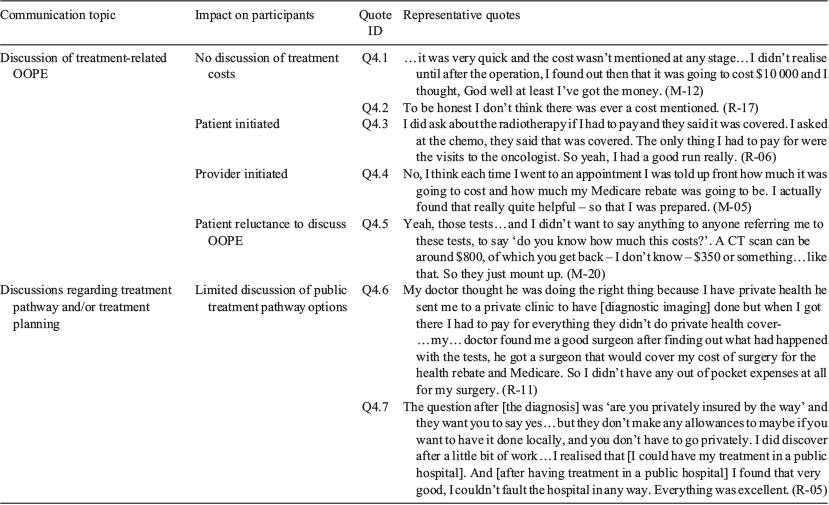
|
Clinicians and service providers did not always mention costs, public versus private treatment options or the financial aid available when discussing treatment options with participants (Table 5, Q4.1, Q4.2, Q4.6 and Q4.7). Conversely, other participants acknowledged transparency in the communication of costs involved or the aid available (Table 5, Q4.3 and Q4.4).
Some participants who experienced difficulty managing their OOPE expressed discomfort at discussing these issues with their doctors (Table 5, Q.5). A participant who chose to discuss unexpected private imaging fees with their general practitioner (GP) found that from that point onward their GP made every effort to minimise their OOPE (Table 5, Q4.6).
Coping strategies for OOPE
Coping with OOPE was reliant on patient financial circumstance and the financial support and assistance available. Participants with sufficient financial resources and/or employment with sufficient leave did not have concerns about OOPE. Coping strategies involved using savings, superannuation, obtaining a credit card to pay costs up front, using available subsidies and strict or maladaptive budgeting; representative quotes from participants are listed in Table 6.
Having to use savings or superannuation jeopardised nine participants’ (22.5%) financial security (Table 6, Q5.4–Q5.6).
The cost of managing treatment side effects proved challenging for some participants. Alarmingly, one participant reported rationing their medication to tolerate the OOPE, whereas another did not use heating during winter to reduce their electricity bill and balance the household budget against their unexpected treatment costs (Table 6, Q5.8–Q5.10).
Many participants successfully accessed financial assistance such as the PATS scheme to recoup travel and accommodation costs. Some found the paperwork difficult to complete (Table 6, Q5.13–Q5.15). For participants living week to week on low incomes, partial cover of travel expenses by PATS was useful, but sometimes left them in financially stressful positions (Table 6, Q5.14).
Discussion
The diverse range of experiences reported by participants in this study highlights inconsistencies in cost communication for treatments and financial assistance. Participants’ experiences were similar to those reported previously in Australia’s and Ireland’s mixed private–public healthcare systems.16,22 In this study we built on published definitions and models of financial toxicity2,38 to develop a modified version of the Flowchart of Economic Consequences of Cancer Treatment on the Patient and Patient Coping developed by Carrera et al.14 to describe patient experiences in Australia’s public–private healthcare system. Our model recognises the multitude of factors that influence the initial treatment-seeking behaviour in the mixed healthcare setting, where PHI is not a limiting factor for treatment-seeking behaviour. Instead, PHI affects the decisions that patients make regarding their treatment type, location and providers. This model can be used to identify areas of patients’ needs and develop support and strategies to optimise care. It also serves as an impetus for health professionals and service providers in developing greater cost transparency.
This study and the growing body of cancer cost literature show OOPE had less of an effect on the patient experience than a patient’s personal financial situation, eligibility for support, experience within the healthcare system and health literacy, which can have devastating downstream ramifications for patients.12,13,23,39 This is reflected in Fig. 1. For example, participants with substantial savings reported less financial difficulties than pensioners without financial resources who had many, but not all, costs subsidised. Although some patients comfortably used savings and superannuation to pay for treatment, the financial sacrifice had a larger effect on others with extraneous debts or family circumstances. Future research into financial toxicity must couple monetary measures with objective and subjective measures to understand the effects of OOPE because current monetary measures, such as the concept of a financial catastrophe, which is defined as an individual spending more than 10% of their household income on care,40 may not sufficiently account for participants’ savings and disposable assets.
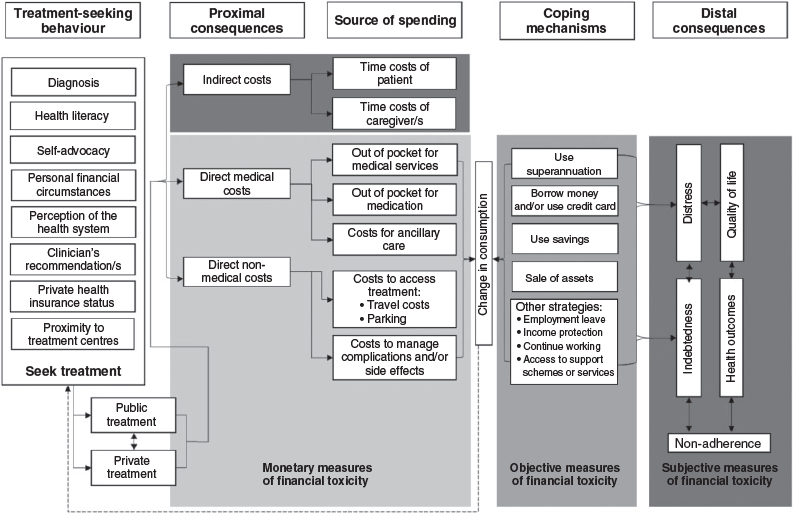
|
Participant experiences suggest inconsistent communication from health professionals regarding treatment costs and financial aid available. Because some participants felt uncomfortable discussing treatment costs with their doctor, there is a need to destigmatise these conversations given their potential for reducing patient OOPE. In light of evidence that some clinicians use age, healthcare card status and PHI as proxies for income and charge presumed high-income patients more for appointments,41 routine assessment of financial needs throughout the patients’ cancer journey would contribute to an objective referral system for financial support. The importance of such a practice is demonstrated by the experience of one participant, who only learned of the total cost of their treatment, which was around A$10 000, after their surgery (Table 3, Q2.7). An adaption of the ‘Ask, Advise, Refer’ approach and financial transparency guidelines have been developed for health professionals and service providers to tackle the issue of information asymmetry, using the concept of informed financial consent to convey the gravity and associated responsibility of informing patients of costs associated with their care.13,42 In addition, recommendations from the Actuaries Institute suggest the development of simple trauma insurance to provide financial relief following a cancer diagnosis.43 Beyond financial compensation and equipping patients to make informed healthcare decisions, the gaps in Australia’s current fee-for-service model for some diagnostic tests, and in a landscape of rapidly emerging new and costly technology, deserve greater investigation to identify the best way to balance the costs borne by providers and participants in the delivery and receipt of health care.
The variability in patient awareness and utilisation of financial assistance further highlight the need for systematically integrating cost conversations into patient consultations. Financial assistance schemes could be reviewed to ensure they are equitably distributed and accessible for those who need it. Previous research undertaken in WA suggested that older patients were at risk of disadvantaged access to services and support.44
The findings of the present study are consistent with the literature, which indicates that employed cancer patients are at a greater risk of financial toxicity and face employment-related challenges that require further attention and support.23,45 Strict eligibility criteria for financial assistance prevented several participants who became unemployed as a result of their diagnosis from accessing assistance, despite their drastic changes in circumstances and income. Given that these participants acknowledged the importance of working for their mental and financial well-being, financial support for self-employed workers who fall ill should be considered. In addition, the adherence to fair work practices for casual employees who fall sick deserves further exploration based on these findings.
Surprisingly, the differences between rural and outer-metropolitan participants did not result in significant differences in the themes that arose; hence, it is not a focus of this paper. Due to the establishment of cancer treatment services in outer-metropolitan and rural settings, many participants undergoing chemotherapy and/or routine surgery did not have to travel great distances to receive all necessary care following their diagnosis. The effects of these rural services have recently been explored by Birch et al.,46 who found that distance and the associated financial burden were important factors for rural cancer patients in accessing the most proximal care. We did note that outer-metropolitan participants more commonly discussed parking costs, whereas rural participants were more affected by accommodation issues (or lack thereof, when they successfully accessed subsidised accommodation provided by NGOs). More rural participants noted the disruption to their work that travel for appointments and treatment caused; however, most had sufficient leave to account for this. As discussed previously, those working in physically demanding roles (regardless of rurality) struggled the most with being unable to work, and eventually needing to change roles.
Ongoing treatment-related complications were common to many participants. These are particularly concerning as they decreased patients’ and their families’ standard of living and, as we found, resulted in maladaptive coping strategies that can have devastating implications on quality of life and clinical consequences. This highlights the importance of financial support mechanisms and subsidies for ongoing costs to maintain quality of life and alleviate financial distress. This issue is only addressed through the Medicare and Pharmaceutical Benefits Scheme safety nets in Australia, in which participants who do not qualify for concessions need to spend a certain amount before being eligible for concessions for some medications and services. The size of this problem needs further investigation to develop appropriate interventions.
Study strengths and limitations
We used a purposive sampling strategy to ensure a diverse range of participants was represented in the data, but this may have led to researcher bias based on our selective criteria. Although we focused on characteristics that would affect patient costs (Table 1) and took findings from similar studies into consideration, there may be other factors influencing patient costs not accounted for in this patient sample, such as socioeconomic status, marital status, social support available, home ownership status and disposable household income. In addition, lung cancer patients were underrepresented in the interviews, because some patients had become progressively sicker and many had passed away. Further research focusing on these cancer patient populations could add greater depth to the adapted model. Finally, patient validation was not used to confirm the themes extracted from the data. Instead, we relied on methods such as researcher triangulation and peer debriefing throughout the analysis to verify the themes identified.
Conclusion
OOPE affected all participants in various ways mediated by a complex range of personal, systemic and financial factors. Given the growing body of evidence highlighting the downstream effects of cancer costs, action is necessary to address the financial strain and distress caused by cancer costs. Health providers need to be more forthcoming with information about treatment costs and the financial support available to avoid unintentionally putting patients in financially compromising positions. Financial assistance schemes need to be reviewed to ensure they are equitably delivered and accessible for cancer patients who need assistance. Further research into cancer care pathways and cost communication interventions is warranted to identify potential interventions or models of care that can reduce the financial burden for cancer patients.
Competing interests
The authors declare no competing interests.
Acknowledgements
The authors thank Ruth McConigley for help with the planning and conceptualisation of the study, Catalina Lizama for help with data collection and Rachel Singer for transcribing the interviews. This research was funded by the Cancer Council of Western Australia and the Western Australian Government Department of Health through the WA Cancer and Palliative Care Network. The authors have full control of the primary data and are able to provide access upon request if deemed appropriate by all investigators.
References
[1] Altice CK, Banegas MP, Tucker-Seeley RD, Yabroff KR. Financial hardships experienced by cancer survivors: a systematic review. J Natl Cancer Inst 2017; 109 djw205| Financial hardships experienced by cancer survivors: a systematic review.Crossref | GoogleScholarGoogle Scholar | 27754926PubMed |
[2] Gordon LG, Merollini KMD, Lowe A, Chan RJ. A systematic review of financial toxicity among cancer survivors: we can’t pay the co-pay. Patient 2017; 10 295–309.
| A systematic review of financial toxicity among cancer survivors: we can’t pay the co-pay.Crossref | GoogleScholarGoogle Scholar | 27798816PubMed |
[3] Zafar SY, Peppercorn JM, Schrag D, Taylor DH, Goetzinger AM, Zhong X, Abernathy AP. The financial toxicity of cancer treatment: a pilot study assessing out-of-pocket expenses and the insured cancer patient’s experience. Oncologist 2013; 18 381–90.
| The financial toxicity of cancer treatment: a pilot study assessing out-of-pocket expenses and the insured cancer patient’s experience.Crossref | GoogleScholarGoogle Scholar | 23442307PubMed |
[4] Sandelowski M. Whatever happened to qualitative description? Res Nurs Health 2000; 23 334–40.
| Whatever happened to qualitative description?Crossref | GoogleScholarGoogle Scholar | 10940958PubMed |
[5] Zafar SY, Chino F, Ubel PA, Rushing C, Samsa G, Altomare I, Nicolla J, Schrag D, Tulsky JA, Abernethy AP, Peppercorn JM. The utility of cost discussions between patients with cancer and oncologists. Am J Manag Care 2015; 9 607–15.
[6] Henrikson NB, Shankaran V. Improving price transparency in cancer care. J Oncol Pract 2016; 12 44–7.
| Improving price transparency in cancer care.Crossref | GoogleScholarGoogle Scholar | 26759467PubMed |
[7] Currow D, Aranda S. Financial toxicity in clinical care today: a ‘menu without prices’. Med J Aust 2016; 204 397
| Financial toxicity in clinical care today: a ‘menu without prices’.Crossref | GoogleScholarGoogle Scholar | 27318391PubMed |
[8] Gordon LG, Walker SM, Mervin MC, Lowe A, Smith DP, Gardiner RA, Chambers SK. Financial toxicity: a potential side effect of prostate cancer treatment among Australian men. Eur J Cancer Care (Engl) 2017; 26 e12392
| Financial toxicity: a potential side effect of prostate cancer treatment among Australian men.Crossref | GoogleScholarGoogle Scholar |
[9] Mervin MC, Lowe A, Gardiner RA, Smith DP, Aitken J, Chambers SK, Gordon LG. What does it cost Medicare to diagnose and treat men with localized prostate cancer in the first year? Asia Pac J Clin Oncol 2017; 13 152–9.
| What does it cost Medicare to diagnose and treat men with localized prostate cancer in the first year?Crossref | GoogleScholarGoogle Scholar | 28303657PubMed |
[10] Paul C, Boyes A, Hall A, Bisquera A, Miller A, O’Brien L. The impact of cancer diagnosis and treatment on employment, income, treatment decisions and financial assistance and their relationship to socioeconomic and disease factors. Support Care Cancer 2016; 24 4739–46.
| The impact of cancer diagnosis and treatment on employment, income, treatment decisions and financial assistance and their relationship to socioeconomic and disease factors.Crossref | GoogleScholarGoogle Scholar | 27364149PubMed |
[11] Consumers Health Forum of Australia. Out of pocket pain. Research report. 2018. Available at: https://chf.org.au/sites/default/files/20180404_oop_report.pdf [verified 12 April 2018].
[12] Breast Cancer Network Australia. Brest Cancer Network Australia’s state of the nation report. 2018. Available at: https://www.bcna.org.au/media/6656/sotn-report-lowres.pdf [verified 15 June 2018].
[13] Sanchia A, Kate W. Patient out-of-pocket expenses. Asia-Pac J Clin Oncol 2018; 14 85–6.
[14] Carrera PM, Kantarjian HM, Blinder VS. The financial burden and distress of patients with cancer: understanding and stepping-up action on the financial toxicity of cancer treatment. CA Cancer J Clin 2018; 68 153–65.
| The financial burden and distress of patients with cancer: understanding and stepping-up action on the financial toxicity of cancer treatment.Crossref | GoogleScholarGoogle Scholar | 29338071PubMed |
[15] McGrath P. Financial assistance for patients who relocate for specialist care in hematology: practical findings to inform nursing supportive care. Nurs Forum 2017; 52 55–61.
| Financial assistance for patients who relocate for specialist care in hematology: practical findings to inform nursing supportive care.Crossref | GoogleScholarGoogle Scholar | 28152210PubMed |
[16] McGrath P. ‘The bills that were coming in…’: out of pocket costs during relocation for specialist treatment for haematological malignancies. Support Care Cancer 2016; 24 2893–903.
| ‘The bills that were coming in…’: out of pocket costs during relocation for specialist treatment for haematological malignancies.Crossref | GoogleScholarGoogle Scholar | 26847347PubMed |
[17] McGrath P. Financial distress during relocation for treatment of a hematological malignancy: findings for social work. Soc Work Health Care 2016; 55 265–79.
| Financial distress during relocation for treatment of a hematological malignancy: findings for social work.Crossref | GoogleScholarGoogle Scholar | 26939936PubMed |
[18] McGrath P. Overcoming the distance barrier in relation to treatment for haematology patients: Queensland findings. Aust Health Rev 2015; 39 344–50.
| Overcoming the distance barrier in relation to treatment for haematology patients: Queensland findings.Crossref | GoogleScholarGoogle Scholar | 25587797PubMed |
[19] McGrath P. ‘You never leave work when you live on a cattle property’: special problems for rural property owners who have to relocate for specialist treatment. Aust J Rural Health 2015; 23 286–90.
| ‘You never leave work when you live on a cattle property’: special problems for rural property owners who have to relocate for specialist treatment.Crossref | GoogleScholarGoogle Scholar | 25946104PubMed |
[20] Longo CJ, Fitch M, Grignon M, McAndrew A. Understanding the full breadth of cancer-related patient costs in Ontario: a qualitative exploration. Support Care Cancer 2016; 24 4541–8.
| Understanding the full breadth of cancer-related patient costs in Ontario: a qualitative exploration.Crossref | GoogleScholarGoogle Scholar | 27271866PubMed |
[21] Smith SK, Nicolla J, Zafar SY. Bridging the gap between financial distress and available resources for patients with cancer: a qualitative study. J Oncol Pract 2014; 10 e368–72.
| Bridging the gap between financial distress and available resources for patients with cancer: a qualitative study.Crossref | GoogleScholarGoogle Scholar | 24865219PubMed |
[22] Timmons A, Gooberman-Hill R, Sharp L. The multidimensional nature of the financial and economic burden of a cancer diagnosis on patients and their families: qualitative findings from a country with a mixed public–private healthcare system. Support Care Cancer 2013; 21 107–17.
| The multidimensional nature of the financial and economic burden of a cancer diagnosis on patients and their families: qualitative findings from a country with a mixed public–private healthcare system.Crossref | GoogleScholarGoogle Scholar | 22987093PubMed |
[23] Pearce A, Tomalin B, Kaambwa B, Horevoorts N, Duijts S, Mols F, van de Poll-Franse L, Koczwara B. Financial toxicity is more than costs of care: the relationship between employment and financial toxicity in long-term cancer survivors. J Cancer Surviv 2019; 13 10–20.
| 30357537PubMed |
[24] Gordon LG, Ferguson M, Chambers SK, Dunn J. Fuel, beds, meals and meds: out-of-pocket expenses for patients with cancer in rural Queensland. Cancer Forum 2009; 33 202–8.
[25] Paul CL, Hall AE, Carey ML, Cameron EC, Clinton-McHarg T. Access to care and impacts of cancer on daily life: do they differ for metropolitan versus regional hematological cancer survivors? J Rural Health 2013; 29 s43–50.
| Access to care and impacts of cancer on daily life: do they differ for metropolitan versus regional hematological cancer survivors?Crossref | GoogleScholarGoogle Scholar | 23944279PubMed |
[26] Zucca A, Boyes A, Newling G, Hall A, Girgis A. Travelling all over the countryside: travel-related burden and financial difficulties reported by cancer patients in New South Wales and Victoria. Aust J Rural Health 2011; 19 298–305.
| Travelling all over the countryside: travel-related burden and financial difficulties reported by cancer patients in New South Wales and Victoria.Crossref | GoogleScholarGoogle Scholar | 22098213PubMed |
[27] Hegney D, Pearce S, Rogers-Clark C, Martin-Mcdonald K, Buikstra E. Close, but still too far. The experience of Australian people with cancer commuting from a regional to a capital city for radiotherapy treatment. Eur J Cancer Care (Engl) 2005; 14 75–82.
| Close, but still too far. The experience of Australian people with cancer commuting from a regional to a capital city for radiotherapy treatment.Crossref | GoogleScholarGoogle Scholar |
[28] Australian Institute of Health and Welfare (AIHW). Australia’s health 2018. Australia’s Health Series no. 16. AUS 221. Canberra: AIHW; 2018.
[29] Australian Institute of Health and Welfare (AIHW). Australia’s welfare 2017. Australia’s Welfare Series no. 13. AUS 214. Canberra: AIHW; 2017.
[30] Australian Department of Human Services. Medicare safety nets. 2018. Available at: https://www.humanservices.gov.au/individuals/services/medicare/medicare-safety-net [verified 5 May 2019].
[31] Australian Government Department of Human Services. PBS safety net thresholds. 2019. Available at: https://www.humanservices.gov.au/individuals/services/medicare/pharmaceutical-benefits-scheme/when-you-spend-lot-pbs-medicines/pbs-safety-net-thresholds [verified 5 May 2019].
[32] Australian Prudential Regulation Association. Quarterly private health insurance statistics. Private health insurance statistical trends. 2018. Available at: https://www.apra.gov.au/publications/private-health-insurance-statistical-trends [verified 5 May 2019].
[33] Australian Prudential Regulation Association. Statistics. Quarterly private health insurance statistics December 2018 (released 14 February 2019). 2019. Available at: https://www.apra.gov.au/sites/default/files/private_health_insurance_quarterly_statistics_december_2018.pdf [verified 3 May 2019].
[34] WA Country Health Service, Government of Western Australia. Patient assisted travel scheme (PATS). 2011. Available at: http://www.wacountry.health.wa.gov.au/index.php?id=pats. [verified 23 April 2018].
[35] Newton JC, Johnson CE, Hohnen H, Bulsara M, Ives A, McKiernan S, Platt V, McConigley R, Slavova-Azmanova N, Saunders C. Out-of-pocket expenses experienced by rural Western Australians diagnosed with cancer. Support Care Cancer 2018; 26 3543–52.
| Out-of-pocket expenses experienced by rural Western Australians diagnosed with cancer.Crossref | GoogleScholarGoogle Scholar | 29704109PubMed |
[36] Given LM. The Sage encyclopedia of qualitative research methods. Thousand Oaks: Sage Publications; 2008.
[37] Braun V, Clarke V. Using thematic analysis in psychology. Qual Res Psychol 2006; 3 77–101.
| Using thematic analysis in psychology.Crossref | GoogleScholarGoogle Scholar |
[38] Ó Céilleachair A, Costello L, Finn C, Timmons A, Fitzpatrick P, Kapur K, Staines A, Sharp L. Inter-relationships between the economic and emotional consequences of colorectal cancer for patients and their families: a qualitative study. BMC Gastroenterol 2012; 12 62
| Inter-relationships between the economic and emotional consequences of colorectal cancer for patients and their families: a qualitative study.Crossref | GoogleScholarGoogle Scholar |
[39] Sharp L, O’Leary E, O’Ceilleachair A, Skally M, Hanly P. Financial impact of colorectal cancer and its consequences: associations between cancer-related financial stress and strain and health-related quality of life. Dis Colon Rectum 2018; 61 27–35.
| Financial impact of colorectal cancer and its consequences: associations between cancer-related financial stress and strain and health-related quality of life.Crossref | GoogleScholarGoogle Scholar | 29219919PubMed |
[40] World Health Organization. Monitoring the building blocks of health systems: a handbook of indicators and their measurement strategies. 2010. Available at: http://www.who.int/healthinfo/systems/WHO_MBHSS_2010_full_web.pdf [verified 20 August 2017].
[41] Johar M, Mu C, Van Gool K, Wong CY. Bleeding hearts, profiteers, or both: specialist physician fees in an unregulated market. Health Econ 2017; 26 528–35.
| Bleeding hearts, profiteers, or both: specialist physician fees in an unregulated market.Crossref | GoogleScholarGoogle Scholar | 26913491PubMed |
[42] Shih YT, Chien CR. A review of cost communication in oncology: patient attitude, provider acceptance, and outcome assessment. Cancer 2017; 123 928–39.
| A review of cost communication in oncology: patient attitude, provider acceptance, and outcome assessment.Crossref | GoogleScholarGoogle Scholar | 27893929PubMed |
[43] Lowe A, Reid J. The dialogue: leading the conversation. Private health insurance bill shock: what can insurers do to help? Sydney: Actuaries Institute; 2017. Available at: https://actuaries.asn.au/Library/Miscellaneous/2017/TheDialogueIssue1Embargo2.pdf [verified 20 May 2019].
[44] Moorin R, Gibson D, Bulsara CE, Holman CD. Challenging the perceptions of cancer service provision for the disadvantaged: evaluating utilisation of cancer support services in Western Australia. Support Care Cancer 2012; 20 1687–97.
| Challenging the perceptions of cancer service provision for the disadvantaged: evaluating utilisation of cancer support services in Western Australia.Crossref | GoogleScholarGoogle Scholar | 21947411PubMed |
[45] McGrath C, Mihala G, Beesley VL, Lynch BM, Graves N, Gordon LG. ‘Cancer put my life on hold’: work-related challenges among middle-aged adults 12 months after a diagnosis of colorectal cancer. Cancer Nurs 2017; 40 160–7.
| ‘Cancer put my life on hold’: work-related challenges among middle-aged adults 12 months after a diagnosis of colorectal cancer.Crossref | GoogleScholarGoogle Scholar | 26925997PubMed |
[46] Birch EM, Haigh MM, Baxi S, Lyford M, Cheetham S, Shahid S, Thompson SC. Exploring treatment decision-making in cancer management for rural residents: Patient and provider perspectives on a recently established regional radiotherapy service. Asia Pac J Clin Oncol 2018; 14 e505–11.
| Exploring treatment decision-making in cancer management for rural residents: Patient and provider perspectives on a recently established regional radiotherapy service.Crossref | GoogleScholarGoogle Scholar | 29582558PubMed |



